Case Study Report: Strategic Human Resource Management in the NHS
VerifiedAdded on 2020/12/29
|12
|3436
|461
Report
AI Summary
This report presents a case study analysis of the National Health Service (NHS), focusing on strategic human resource management (HRM). The report delves into three key areas: leadership and management, training and development (T&D), and talent management. It explores different leadership styles, such as transformational, autocratic, democratic, and laissez-faire, and their application within the NHS context. The role of managers and the HR department in these areas is examined, including interpersonal, informational, and decisional roles. The report also discusses the influence of internal factors (employees, managers, board of directors) and external factors (competitors, customers, suppliers) on leadership, T&D, and talent management. Theoretical models for T&D, including the System Model and Transitional Model, are presented, along with the importance of T&D programs. The report highlights various training methods like On-the-Job and Off-the-Job training. Finally, it addresses talent management concepts like talent pools, pipelines, and factories, and their significance in the NHS. The study concludes with an overview of NHS management roles and priorities in talent acquisition and development.

NHS CASE STUDY
Paraphrase This Document
Need a fresh take? Get an instant paraphrase of this document with our AI Paraphraser
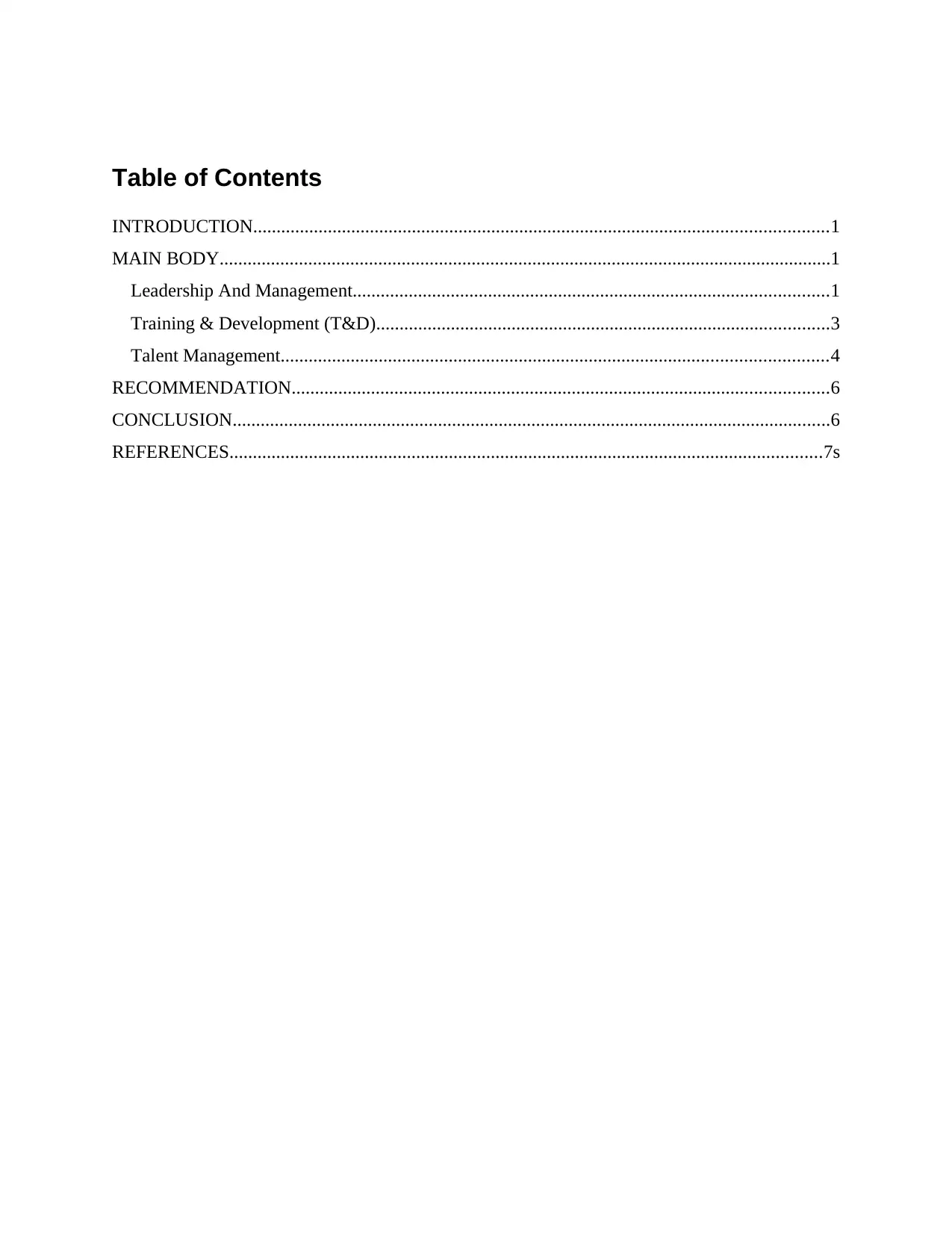
Table of Contents
INTRODUCTION...........................................................................................................................1
MAIN BODY...................................................................................................................................1
Leadership And Management......................................................................................................1
Training & Development (T&D).................................................................................................3
Talent Management.....................................................................................................................4
RECOMMENDATION...................................................................................................................6
CONCLUSION................................................................................................................................6
REFERENCES...............................................................................................................................7s
INTRODUCTION...........................................................................................................................1
MAIN BODY...................................................................................................................................1
Leadership And Management......................................................................................................1
Training & Development (T&D).................................................................................................3
Talent Management.....................................................................................................................4
RECOMMENDATION...................................................................................................................6
CONCLUSION................................................................................................................................6
REFERENCES...............................................................................................................................7s
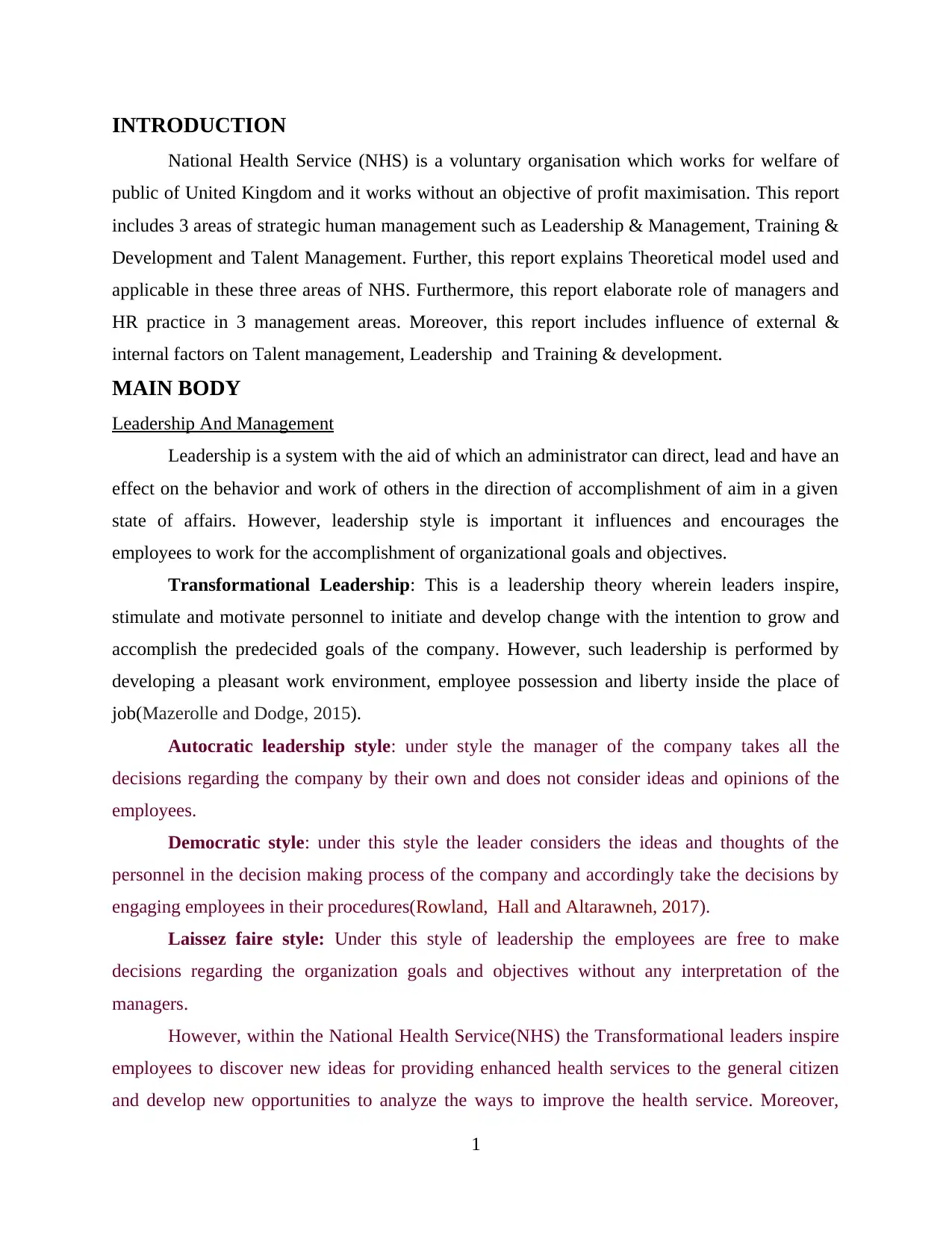
INTRODUCTION
National Health Service (NHS) is a voluntary organisation which works for welfare of
public of United Kingdom and it works without an objective of profit maximisation. This report
includes 3 areas of strategic human management such as Leadership & Management, Training &
Development and Talent Management. Further, this report explains Theoretical model used and
applicable in these three areas of NHS. Furthermore, this report elaborate role of managers and
HR practice in 3 management areas. Moreover, this report includes influence of external &
internal factors on Talent management, Leadership and Training & development.
MAIN BODY
Leadership And Management
Leadership is a system with the aid of which an administrator can direct, lead and have an
effect on the behavior and work of others in the direction of accomplishment of aim in a given
state of affairs. However, leadership style is important it influences and encourages the
employees to work for the accomplishment of organizational goals and objectives.
Transformational Leadership: This is a leadership theory wherein leaders inspire,
stimulate and motivate personnel to initiate and develop change with the intention to grow and
accomplish the predecided goals of the company. However, such leadership is performed by
developing a pleasant work environment, employee possession and liberty inside the place of
job(Mazerolle and Dodge, 2015).
Autocratic leadership style: under style the manager of the company takes all the
decisions regarding the company by their own and does not consider ideas and opinions of the
employees.
Democratic style: under this style the leader considers the ideas and thoughts of the
personnel in the decision making process of the company and accordingly take the decisions by
engaging employees in their procedures(Rowland, Hall and Altarawneh, 2017).
Laissez faire style: Under this style of leadership the employees are free to make
decisions regarding the organization goals and objectives without any interpretation of the
managers.
However, within the National Health Service(NHS) the Transformational leaders inspire
employees to discover new ideas for providing enhanced health services to the general citizen
and develop new opportunities to analyze the ways to improve the health service. Moreover,
1
National Health Service (NHS) is a voluntary organisation which works for welfare of
public of United Kingdom and it works without an objective of profit maximisation. This report
includes 3 areas of strategic human management such as Leadership & Management, Training &
Development and Talent Management. Further, this report explains Theoretical model used and
applicable in these three areas of NHS. Furthermore, this report elaborate role of managers and
HR practice in 3 management areas. Moreover, this report includes influence of external &
internal factors on Talent management, Leadership and Training & development.
MAIN BODY
Leadership And Management
Leadership is a system with the aid of which an administrator can direct, lead and have an
effect on the behavior and work of others in the direction of accomplishment of aim in a given
state of affairs. However, leadership style is important it influences and encourages the
employees to work for the accomplishment of organizational goals and objectives.
Transformational Leadership: This is a leadership theory wherein leaders inspire,
stimulate and motivate personnel to initiate and develop change with the intention to grow and
accomplish the predecided goals of the company. However, such leadership is performed by
developing a pleasant work environment, employee possession and liberty inside the place of
job(Mazerolle and Dodge, 2015).
Autocratic leadership style: under style the manager of the company takes all the
decisions regarding the company by their own and does not consider ideas and opinions of the
employees.
Democratic style: under this style the leader considers the ideas and thoughts of the
personnel in the decision making process of the company and accordingly take the decisions by
engaging employees in their procedures(Rowland, Hall and Altarawneh, 2017).
Laissez faire style: Under this style of leadership the employees are free to make
decisions regarding the organization goals and objectives without any interpretation of the
managers.
However, within the National Health Service(NHS) the Transformational leaders inspire
employees to discover new ideas for providing enhanced health services to the general citizen
and develop new opportunities to analyze the ways to improve the health service. Moreover,
1
⊘ This is a preview!⊘
Do you want full access?
Subscribe today to unlock all pages.

Trusted by 1+ million students worldwide
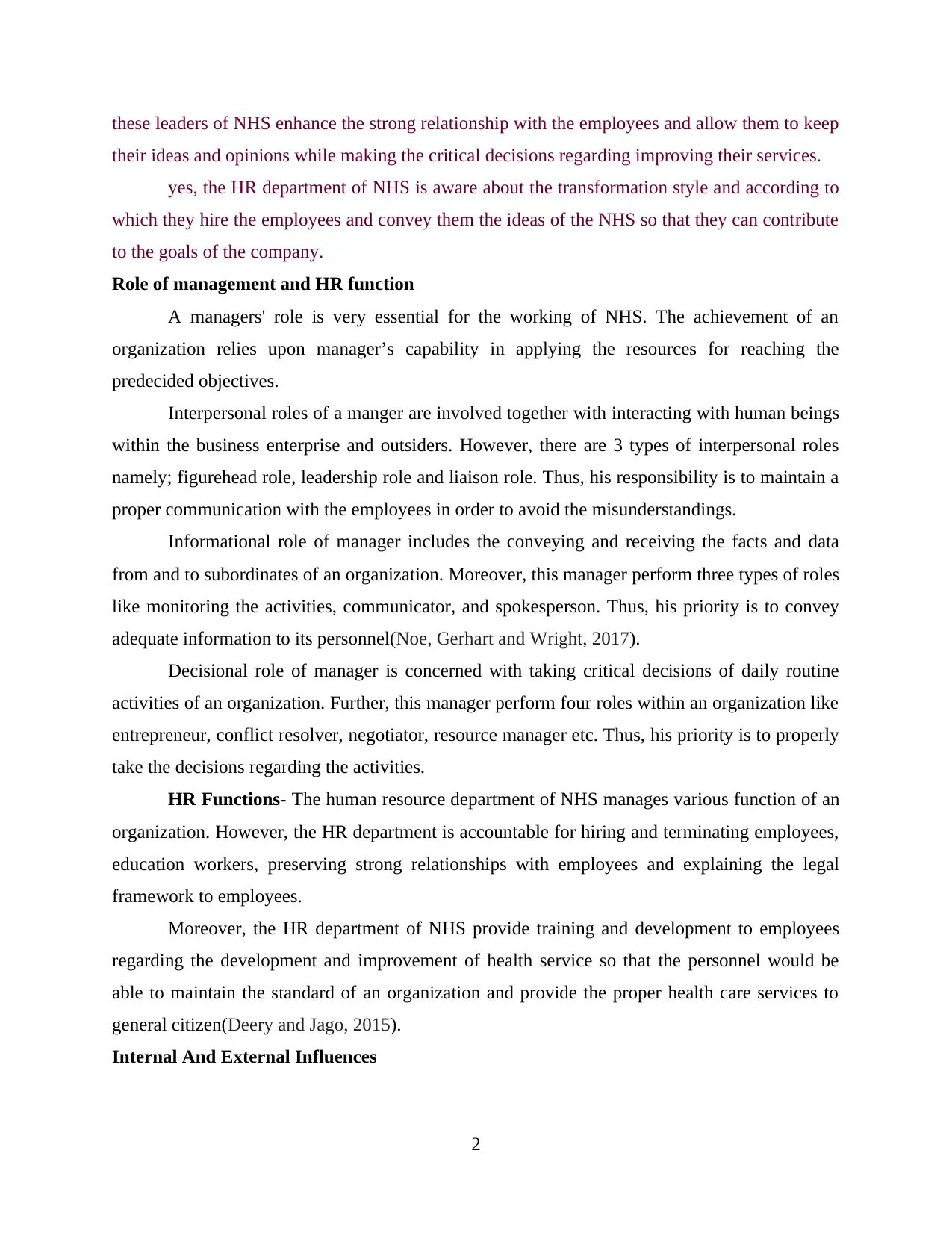
these leaders of NHS enhance the strong relationship with the employees and allow them to keep
their ideas and opinions while making the critical decisions regarding improving their services.
yes, the HR department of NHS is aware about the transformation style and according to
which they hire the employees and convey them the ideas of the NHS so that they can contribute
to the goals of the company.
Role of management and HR function
A managers' role is very essential for the working of NHS. The achievement of an
organization relies upon manager’s capability in applying the resources for reaching the
predecided objectives.
Interpersonal roles of a manger are involved together with interacting with human beings
within the business enterprise and outsiders. However, there are 3 types of interpersonal roles
namely; figurehead role, leadership role and liaison role. Thus, his responsibility is to maintain a
proper communication with the employees in order to avoid the misunderstandings.
Informational role of manager includes the conveying and receiving the facts and data
from and to subordinates of an organization. Moreover, this manager perform three types of roles
like monitoring the activities, communicator, and spokesperson. Thus, his priority is to convey
adequate information to its personnel(Noe, Gerhart and Wright, 2017).
Decisional role of manager is concerned with taking critical decisions of daily routine
activities of an organization. Further, this manager perform four roles within an organization like
entrepreneur, conflict resolver, negotiator, resource manager etc. Thus, his priority is to properly
take the decisions regarding the activities.
HR Functions- The human resource department of NHS manages various function of an
organization. However, the HR department is accountable for hiring and terminating employees,
education workers, preserving strong relationships with employees and explaining the legal
framework to employees.
Moreover, the HR department of NHS provide training and development to employees
regarding the development and improvement of health service so that the personnel would be
able to maintain the standard of an organization and provide the proper health care services to
general citizen(Deery and Jago, 2015).
Internal And External Influences
2
their ideas and opinions while making the critical decisions regarding improving their services.
yes, the HR department of NHS is aware about the transformation style and according to
which they hire the employees and convey them the ideas of the NHS so that they can contribute
to the goals of the company.
Role of management and HR function
A managers' role is very essential for the working of NHS. The achievement of an
organization relies upon manager’s capability in applying the resources for reaching the
predecided objectives.
Interpersonal roles of a manger are involved together with interacting with human beings
within the business enterprise and outsiders. However, there are 3 types of interpersonal roles
namely; figurehead role, leadership role and liaison role. Thus, his responsibility is to maintain a
proper communication with the employees in order to avoid the misunderstandings.
Informational role of manager includes the conveying and receiving the facts and data
from and to subordinates of an organization. Moreover, this manager perform three types of roles
like monitoring the activities, communicator, and spokesperson. Thus, his priority is to convey
adequate information to its personnel(Noe, Gerhart and Wright, 2017).
Decisional role of manager is concerned with taking critical decisions of daily routine
activities of an organization. Further, this manager perform four roles within an organization like
entrepreneur, conflict resolver, negotiator, resource manager etc. Thus, his priority is to properly
take the decisions regarding the activities.
HR Functions- The human resource department of NHS manages various function of an
organization. However, the HR department is accountable for hiring and terminating employees,
education workers, preserving strong relationships with employees and explaining the legal
framework to employees.
Moreover, the HR department of NHS provide training and development to employees
regarding the development and improvement of health service so that the personnel would be
able to maintain the standard of an organization and provide the proper health care services to
general citizen(Deery and Jago, 2015).
Internal And External Influences
2
Paraphrase This Document
Need a fresh take? Get an instant paraphrase of this document with our AI Paraphraser
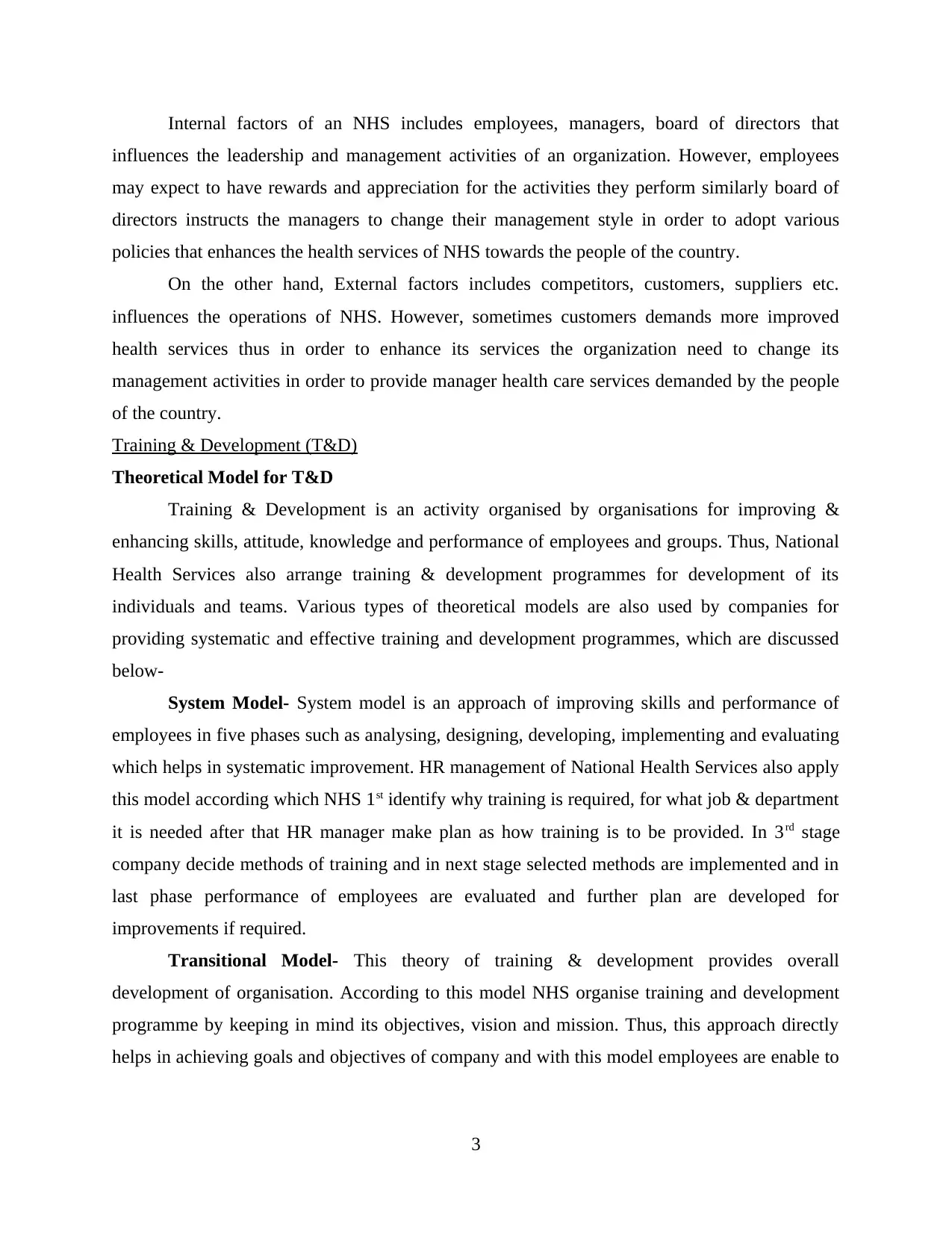
Internal factors of an NHS includes employees, managers, board of directors that
influences the leadership and management activities of an organization. However, employees
may expect to have rewards and appreciation for the activities they perform similarly board of
directors instructs the managers to change their management style in order to adopt various
policies that enhances the health services of NHS towards the people of the country.
On the other hand, External factors includes competitors, customers, suppliers etc.
influences the operations of NHS. However, sometimes customers demands more improved
health services thus in order to enhance its services the organization need to change its
management activities in order to provide manager health care services demanded by the people
of the country.
Training & Development (T&D)
Theoretical Model for T&D
Training & Development is an activity organised by organisations for improving &
enhancing skills, attitude, knowledge and performance of employees and groups. Thus, National
Health Services also arrange training & development programmes for development of its
individuals and teams. Various types of theoretical models are also used by companies for
providing systematic and effective training and development programmes, which are discussed
below-
System Model- System model is an approach of improving skills and performance of
employees in five phases such as analysing, designing, developing, implementing and evaluating
which helps in systematic improvement. HR management of National Health Services also apply
this model according which NHS 1st identify why training is required, for what job & department
it is needed after that HR manager make plan as how training is to be provided. In 3rd stage
company decide methods of training and in next stage selected methods are implemented and in
last phase performance of employees are evaluated and further plan are developed for
improvements if required.
Transitional Model- This theory of training & development provides overall
development of organisation. According to this model NHS organise training and development
programme by keeping in mind its objectives, vision and mission. Thus, this approach directly
helps in achieving goals and objectives of company and with this model employees are enable to
3
influences the leadership and management activities of an organization. However, employees
may expect to have rewards and appreciation for the activities they perform similarly board of
directors instructs the managers to change their management style in order to adopt various
policies that enhances the health services of NHS towards the people of the country.
On the other hand, External factors includes competitors, customers, suppliers etc.
influences the operations of NHS. However, sometimes customers demands more improved
health services thus in order to enhance its services the organization need to change its
management activities in order to provide manager health care services demanded by the people
of the country.
Training & Development (T&D)
Theoretical Model for T&D
Training & Development is an activity organised by organisations for improving &
enhancing skills, attitude, knowledge and performance of employees and groups. Thus, National
Health Services also arrange training & development programmes for development of its
individuals and teams. Various types of theoretical models are also used by companies for
providing systematic and effective training and development programmes, which are discussed
below-
System Model- System model is an approach of improving skills and performance of
employees in five phases such as analysing, designing, developing, implementing and evaluating
which helps in systematic improvement. HR management of National Health Services also apply
this model according which NHS 1st identify why training is required, for what job & department
it is needed after that HR manager make plan as how training is to be provided. In 3rd stage
company decide methods of training and in next stage selected methods are implemented and in
last phase performance of employees are evaluated and further plan are developed for
improvements if required.
Transitional Model- This theory of training & development provides overall
development of organisation. According to this model NHS organise training and development
programme by keeping in mind its objectives, vision and mission. Thus, this approach directly
helps in achieving goals and objectives of company and with this model employees are enable to
3
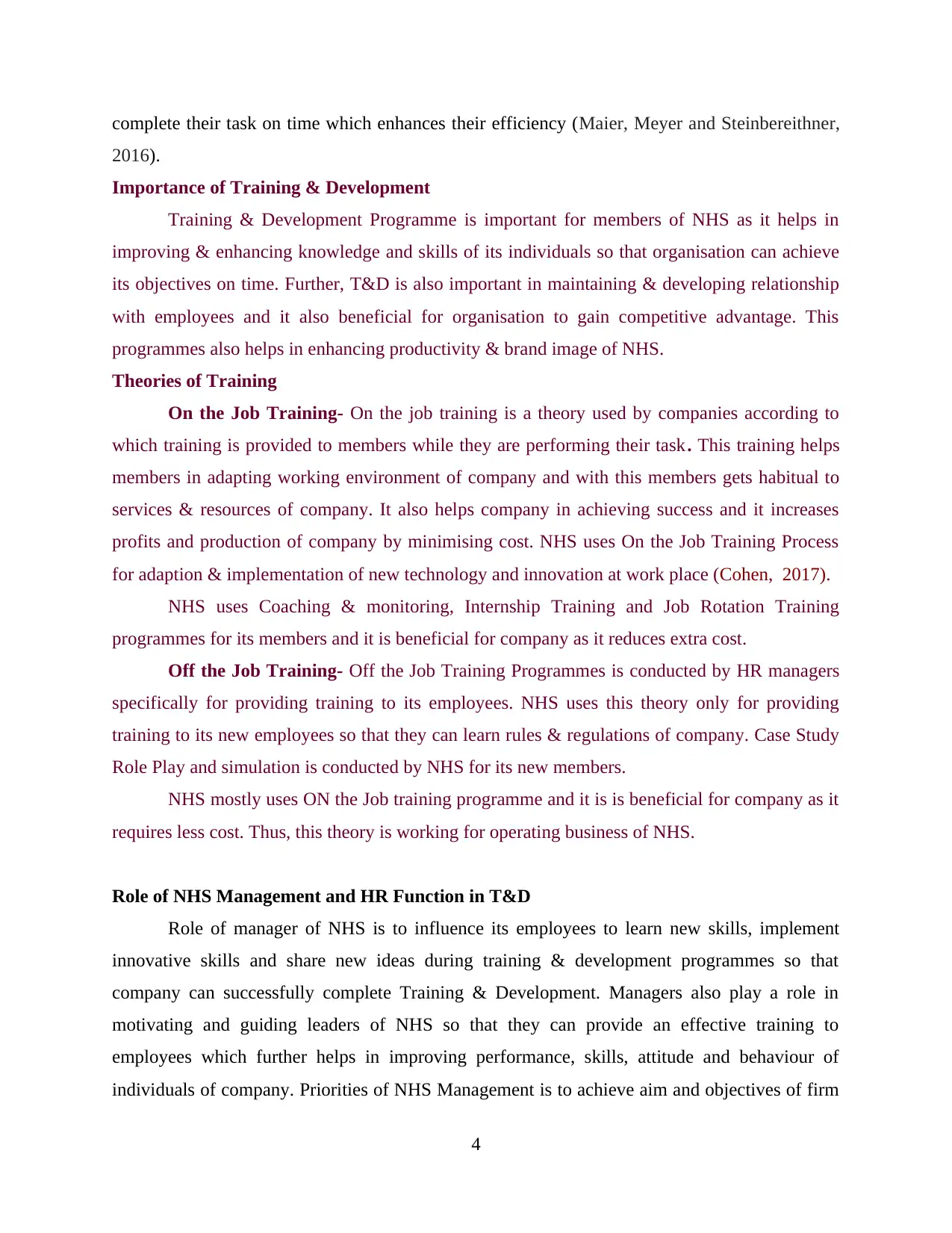
complete their task on time which enhances their efficiency (Maier, Meyer and Steinbereithner,
2016).
Importance of Training & Development
Training & Development Programme is important for members of NHS as it helps in
improving & enhancing knowledge and skills of its individuals so that organisation can achieve
its objectives on time. Further, T&D is also important in maintaining & developing relationship
with employees and it also beneficial for organisation to gain competitive advantage. This
programmes also helps in enhancing productivity & brand image of NHS.
Theories of Training
On the Job Training- On the job training is a theory used by companies according to
which training is provided to members while they are performing their task. This training helps
members in adapting working environment of company and with this members gets habitual to
services & resources of company. It also helps company in achieving success and it increases
profits and production of company by minimising cost. NHS uses On the Job Training Process
for adaption & implementation of new technology and innovation at work place (Cohen, 2017).
NHS uses Coaching & monitoring, Internship Training and Job Rotation Training
programmes for its members and it is beneficial for company as it reduces extra cost.
Off the Job Training- Off the Job Training Programmes is conducted by HR managers
specifically for providing training to its employees. NHS uses this theory only for providing
training to its new employees so that they can learn rules & regulations of company. Case Study
Role Play and simulation is conducted by NHS for its new members.
NHS mostly uses ON the Job training programme and it is is beneficial for company as it
requires less cost. Thus, this theory is working for operating business of NHS.
Role of NHS Management and HR Function in T&D
Role of manager of NHS is to influence its employees to learn new skills, implement
innovative skills and share new ideas during training & development programmes so that
company can successfully complete Training & Development. Managers also play a role in
motivating and guiding leaders of NHS so that they can provide an effective training to
employees which further helps in improving performance, skills, attitude and behaviour of
individuals of company. Priorities of NHS Management is to achieve aim and objectives of firm
4
2016).
Importance of Training & Development
Training & Development Programme is important for members of NHS as it helps in
improving & enhancing knowledge and skills of its individuals so that organisation can achieve
its objectives on time. Further, T&D is also important in maintaining & developing relationship
with employees and it also beneficial for organisation to gain competitive advantage. This
programmes also helps in enhancing productivity & brand image of NHS.
Theories of Training
On the Job Training- On the job training is a theory used by companies according to
which training is provided to members while they are performing their task. This training helps
members in adapting working environment of company and with this members gets habitual to
services & resources of company. It also helps company in achieving success and it increases
profits and production of company by minimising cost. NHS uses On the Job Training Process
for adaption & implementation of new technology and innovation at work place (Cohen, 2017).
NHS uses Coaching & monitoring, Internship Training and Job Rotation Training
programmes for its members and it is beneficial for company as it reduces extra cost.
Off the Job Training- Off the Job Training Programmes is conducted by HR managers
specifically for providing training to its employees. NHS uses this theory only for providing
training to its new employees so that they can learn rules & regulations of company. Case Study
Role Play and simulation is conducted by NHS for its new members.
NHS mostly uses ON the Job training programme and it is is beneficial for company as it
requires less cost. Thus, this theory is working for operating business of NHS.
Role of NHS Management and HR Function in T&D
Role of manager of NHS is to influence its employees to learn new skills, implement
innovative skills and share new ideas during training & development programmes so that
company can successfully complete Training & Development. Managers also play a role in
motivating and guiding leaders of NHS so that they can provide an effective training to
employees which further helps in improving performance, skills, attitude and behaviour of
individuals of company. Priorities of NHS Management is to achieve aim and objectives of firm
4
⊘ This is a preview!⊘
Do you want full access?
Subscribe today to unlock all pages.

Trusted by 1+ million students worldwide
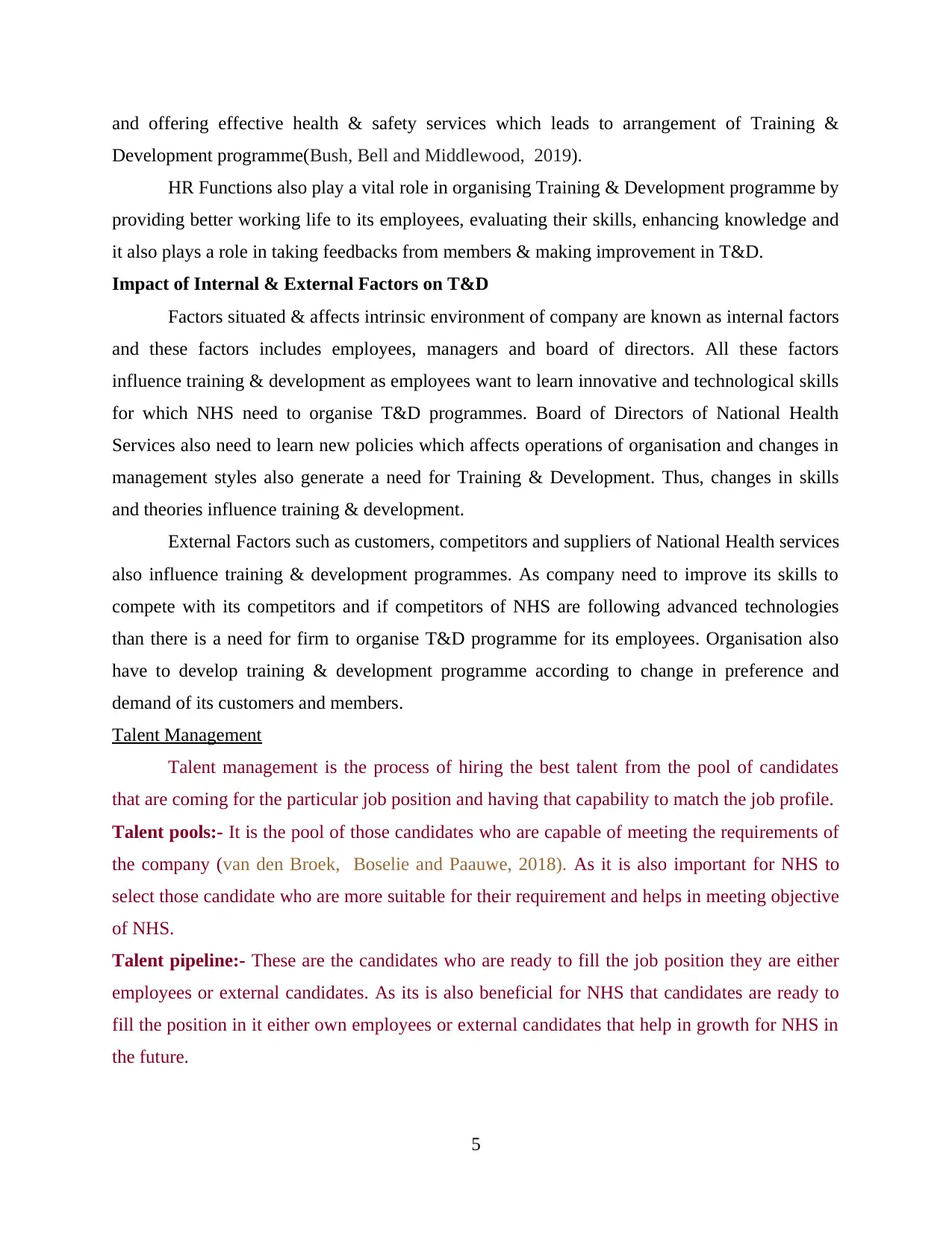
and offering effective health & safety services which leads to arrangement of Training &
Development programme(Bush, Bell and Middlewood, 2019).
HR Functions also play a vital role in organising Training & Development programme by
providing better working life to its employees, evaluating their skills, enhancing knowledge and
it also plays a role in taking feedbacks from members & making improvement in T&D.
Impact of Internal & External Factors on T&D
Factors situated & affects intrinsic environment of company are known as internal factors
and these factors includes employees, managers and board of directors. All these factors
influence training & development as employees want to learn innovative and technological skills
for which NHS need to organise T&D programmes. Board of Directors of National Health
Services also need to learn new policies which affects operations of organisation and changes in
management styles also generate a need for Training & Development. Thus, changes in skills
and theories influence training & development.
External Factors such as customers, competitors and suppliers of National Health services
also influence training & development programmes. As company need to improve its skills to
compete with its competitors and if competitors of NHS are following advanced technologies
than there is a need for firm to organise T&D programme for its employees. Organisation also
have to develop training & development programme according to change in preference and
demand of its customers and members.
Talent Management
Talent management is the process of hiring the best talent from the pool of candidates
that are coming for the particular job position and having that capability to match the job profile.
Talent pools:- It is the pool of those candidates who are capable of meeting the requirements of
the company (van den Broek, Boselie and Paauwe, 2018). As it is also important for NHS to
select those candidate who are more suitable for their requirement and helps in meeting objective
of NHS.
Talent pipeline:- These are the candidates who are ready to fill the job position they are either
employees or external candidates. As its is also beneficial for NHS that candidates are ready to
fill the position in it either own employees or external candidates that help in growth for NHS in
the future.
5
Development programme(Bush, Bell and Middlewood, 2019).
HR Functions also play a vital role in organising Training & Development programme by
providing better working life to its employees, evaluating their skills, enhancing knowledge and
it also plays a role in taking feedbacks from members & making improvement in T&D.
Impact of Internal & External Factors on T&D
Factors situated & affects intrinsic environment of company are known as internal factors
and these factors includes employees, managers and board of directors. All these factors
influence training & development as employees want to learn innovative and technological skills
for which NHS need to organise T&D programmes. Board of Directors of National Health
Services also need to learn new policies which affects operations of organisation and changes in
management styles also generate a need for Training & Development. Thus, changes in skills
and theories influence training & development.
External Factors such as customers, competitors and suppliers of National Health services
also influence training & development programmes. As company need to improve its skills to
compete with its competitors and if competitors of NHS are following advanced technologies
than there is a need for firm to organise T&D programme for its employees. Organisation also
have to develop training & development programme according to change in preference and
demand of its customers and members.
Talent Management
Talent management is the process of hiring the best talent from the pool of candidates
that are coming for the particular job position and having that capability to match the job profile.
Talent pools:- It is the pool of those candidates who are capable of meeting the requirements of
the company (van den Broek, Boselie and Paauwe, 2018). As it is also important for NHS to
select those candidate who are more suitable for their requirement and helps in meeting objective
of NHS.
Talent pipeline:- These are the candidates who are ready to fill the job position they are either
employees or external candidates. As its is also beneficial for NHS that candidates are ready to
fill the position in it either own employees or external candidates that help in growth for NHS in
the future.
5
Paraphrase This Document
Need a fresh take? Get an instant paraphrase of this document with our AI Paraphraser
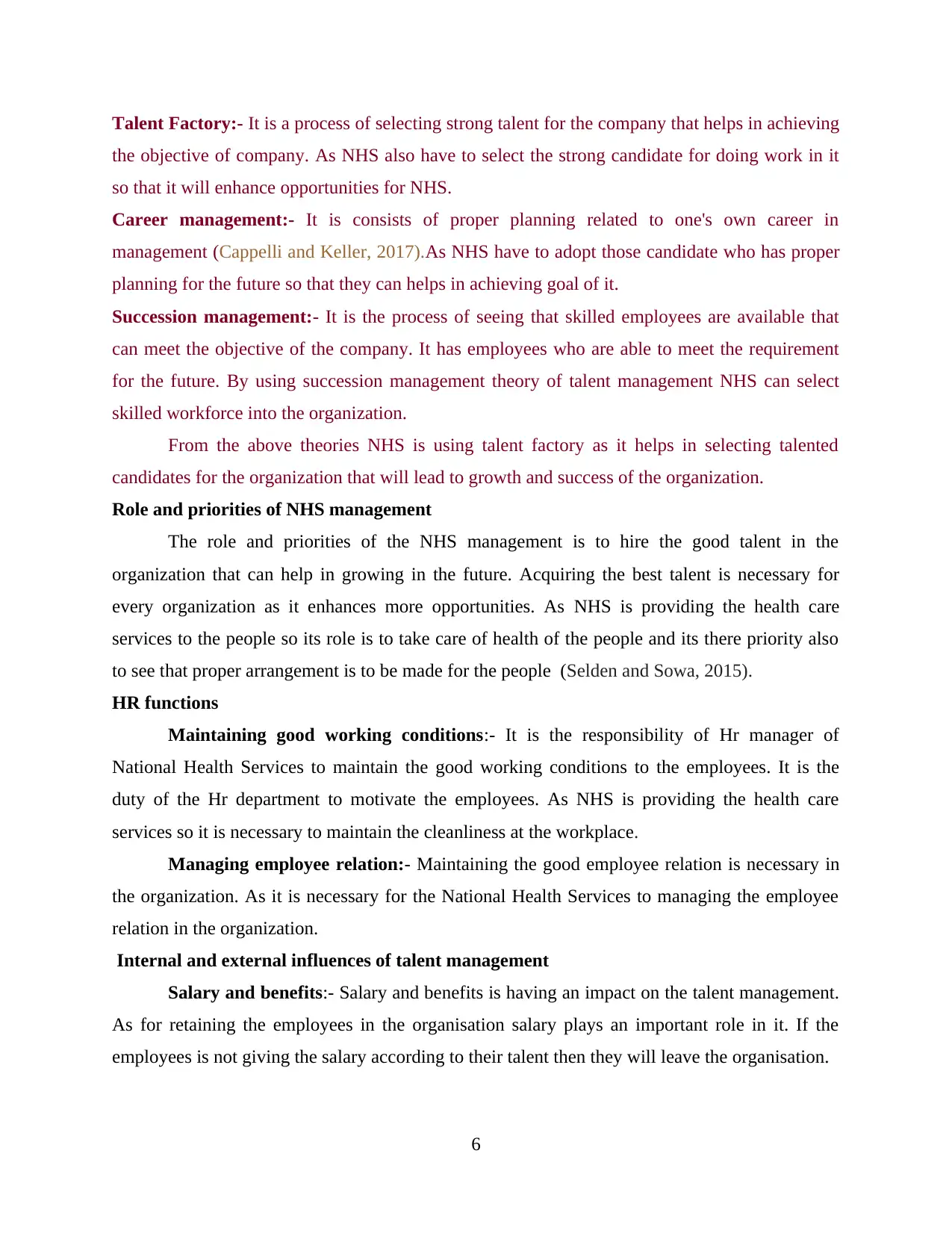
Talent Factory:- It is a process of selecting strong talent for the company that helps in achieving
the objective of company. As NHS also have to select the strong candidate for doing work in it
so that it will enhance opportunities for NHS.
Career management:- It is consists of proper planning related to one's own career in
management (Cappelli and Keller, 2017).As NHS have to adopt those candidate who has proper
planning for the future so that they can helps in achieving goal of it.
Succession management:- It is the process of seeing that skilled employees are available that
can meet the objective of the company. It has employees who are able to meet the requirement
for the future. By using succession management theory of talent management NHS can select
skilled workforce into the organization.
From the above theories NHS is using talent factory as it helps in selecting talented
candidates for the organization that will lead to growth and success of the organization.
Role and priorities of NHS management
The role and priorities of the NHS management is to hire the good talent in the
organization that can help in growing in the future. Acquiring the best talent is necessary for
every organization as it enhances more opportunities. As NHS is providing the health care
services to the people so its role is to take care of health of the people and its there priority also
to see that proper arrangement is to be made for the people (Selden and Sowa, 2015).
HR functions
Maintaining good working conditions:- It is the responsibility of Hr manager of
National Health Services to maintain the good working conditions to the employees. It is the
duty of the Hr department to motivate the employees. As NHS is providing the health care
services so it is necessary to maintain the cleanliness at the workplace.
Managing employee relation:- Maintaining the good employee relation is necessary in
the organization. As it is necessary for the National Health Services to managing the employee
relation in the organization.
Internal and external influences of talent management
Salary and benefits:- Salary and benefits is having an impact on the talent management.
As for retaining the employees in the organisation salary plays an important role in it. If the
employees is not giving the salary according to their talent then they will leave the organisation.
6
the objective of company. As NHS also have to select the strong candidate for doing work in it
so that it will enhance opportunities for NHS.
Career management:- It is consists of proper planning related to one's own career in
management (Cappelli and Keller, 2017).As NHS have to adopt those candidate who has proper
planning for the future so that they can helps in achieving goal of it.
Succession management:- It is the process of seeing that skilled employees are available that
can meet the objective of the company. It has employees who are able to meet the requirement
for the future. By using succession management theory of talent management NHS can select
skilled workforce into the organization.
From the above theories NHS is using talent factory as it helps in selecting talented
candidates for the organization that will lead to growth and success of the organization.
Role and priorities of NHS management
The role and priorities of the NHS management is to hire the good talent in the
organization that can help in growing in the future. Acquiring the best talent is necessary for
every organization as it enhances more opportunities. As NHS is providing the health care
services to the people so its role is to take care of health of the people and its there priority also
to see that proper arrangement is to be made for the people (Selden and Sowa, 2015).
HR functions
Maintaining good working conditions:- It is the responsibility of Hr manager of
National Health Services to maintain the good working conditions to the employees. It is the
duty of the Hr department to motivate the employees. As NHS is providing the health care
services so it is necessary to maintain the cleanliness at the workplace.
Managing employee relation:- Maintaining the good employee relation is necessary in
the organization. As it is necessary for the National Health Services to managing the employee
relation in the organization.
Internal and external influences of talent management
Salary and benefits:- Salary and benefits is having an impact on the talent management.
As for retaining the employees in the organisation salary plays an important role in it. If the
employees is not giving the salary according to their talent then they will leave the organisation.
6
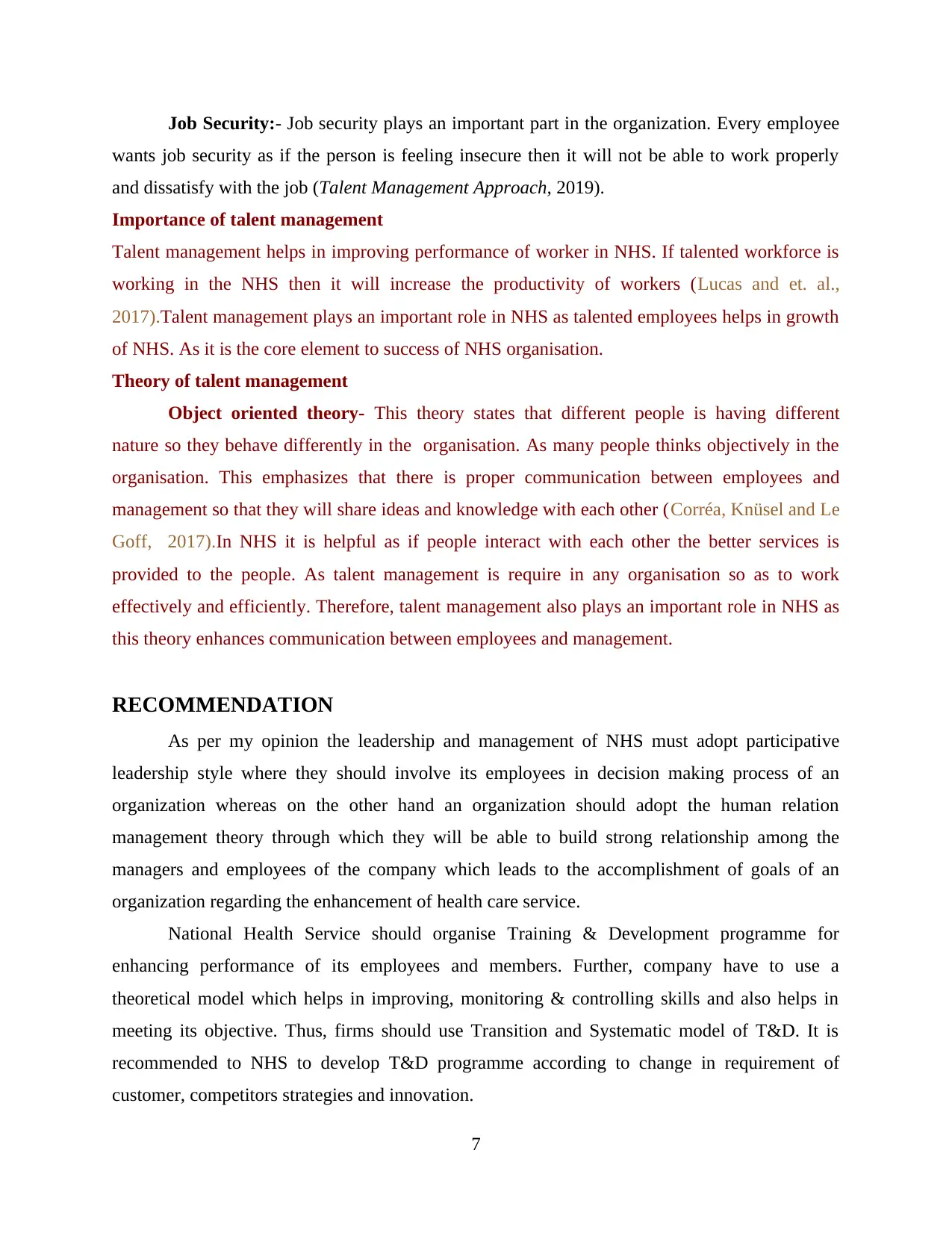
Job Security:- Job security plays an important part in the organization. Every employee
wants job security as if the person is feeling insecure then it will not be able to work properly
and dissatisfy with the job (Talent Management Approach, 2019).
Importance of talent management
Talent management helps in improving performance of worker in NHS. If talented workforce is
working in the NHS then it will increase the productivity of workers (Lucas and et. al.,
2017).Talent management plays an important role in NHS as talented employees helps in growth
of NHS. As it is the core element to success of NHS organisation.
Theory of talent management
Object oriented theory- This theory states that different people is having different
nature so they behave differently in the organisation. As many people thinks objectively in the
organisation. This emphasizes that there is proper communication between employees and
management so that they will share ideas and knowledge with each other (Corréa, Knüsel and Le
Goff, 2017).In NHS it is helpful as if people interact with each other the better services is
provided to the people. As talent management is require in any organisation so as to work
effectively and efficiently. Therefore, talent management also plays an important role in NHS as
this theory enhances communication between employees and management.
RECOMMENDATION
As per my opinion the leadership and management of NHS must adopt participative
leadership style where they should involve its employees in decision making process of an
organization whereas on the other hand an organization should adopt the human relation
management theory through which they will be able to build strong relationship among the
managers and employees of the company which leads to the accomplishment of goals of an
organization regarding the enhancement of health care service.
National Health Service should organise Training & Development programme for
enhancing performance of its employees and members. Further, company have to use a
theoretical model which helps in improving, monitoring & controlling skills and also helps in
meeting its objective. Thus, firms should use Transition and Systematic model of T&D. It is
recommended to NHS to develop T&D programme according to change in requirement of
customer, competitors strategies and innovation.
7
wants job security as if the person is feeling insecure then it will not be able to work properly
and dissatisfy with the job (Talent Management Approach, 2019).
Importance of talent management
Talent management helps in improving performance of worker in NHS. If talented workforce is
working in the NHS then it will increase the productivity of workers (Lucas and et. al.,
2017).Talent management plays an important role in NHS as talented employees helps in growth
of NHS. As it is the core element to success of NHS organisation.
Theory of talent management
Object oriented theory- This theory states that different people is having different
nature so they behave differently in the organisation. As many people thinks objectively in the
organisation. This emphasizes that there is proper communication between employees and
management so that they will share ideas and knowledge with each other (Corréa, Knüsel and Le
Goff, 2017).In NHS it is helpful as if people interact with each other the better services is
provided to the people. As talent management is require in any organisation so as to work
effectively and efficiently. Therefore, talent management also plays an important role in NHS as
this theory enhances communication between employees and management.
RECOMMENDATION
As per my opinion the leadership and management of NHS must adopt participative
leadership style where they should involve its employees in decision making process of an
organization whereas on the other hand an organization should adopt the human relation
management theory through which they will be able to build strong relationship among the
managers and employees of the company which leads to the accomplishment of goals of an
organization regarding the enhancement of health care service.
National Health Service should organise Training & Development programme for
enhancing performance of its employees and members. Further, company have to use a
theoretical model which helps in improving, monitoring & controlling skills and also helps in
meeting its objective. Thus, firms should use Transition and Systematic model of T&D. It is
recommended to NHS to develop T&D programme according to change in requirement of
customer, competitors strategies and innovation.
7
⊘ This is a preview!⊘
Do you want full access?
Subscribe today to unlock all pages.

Trusted by 1+ million students worldwide
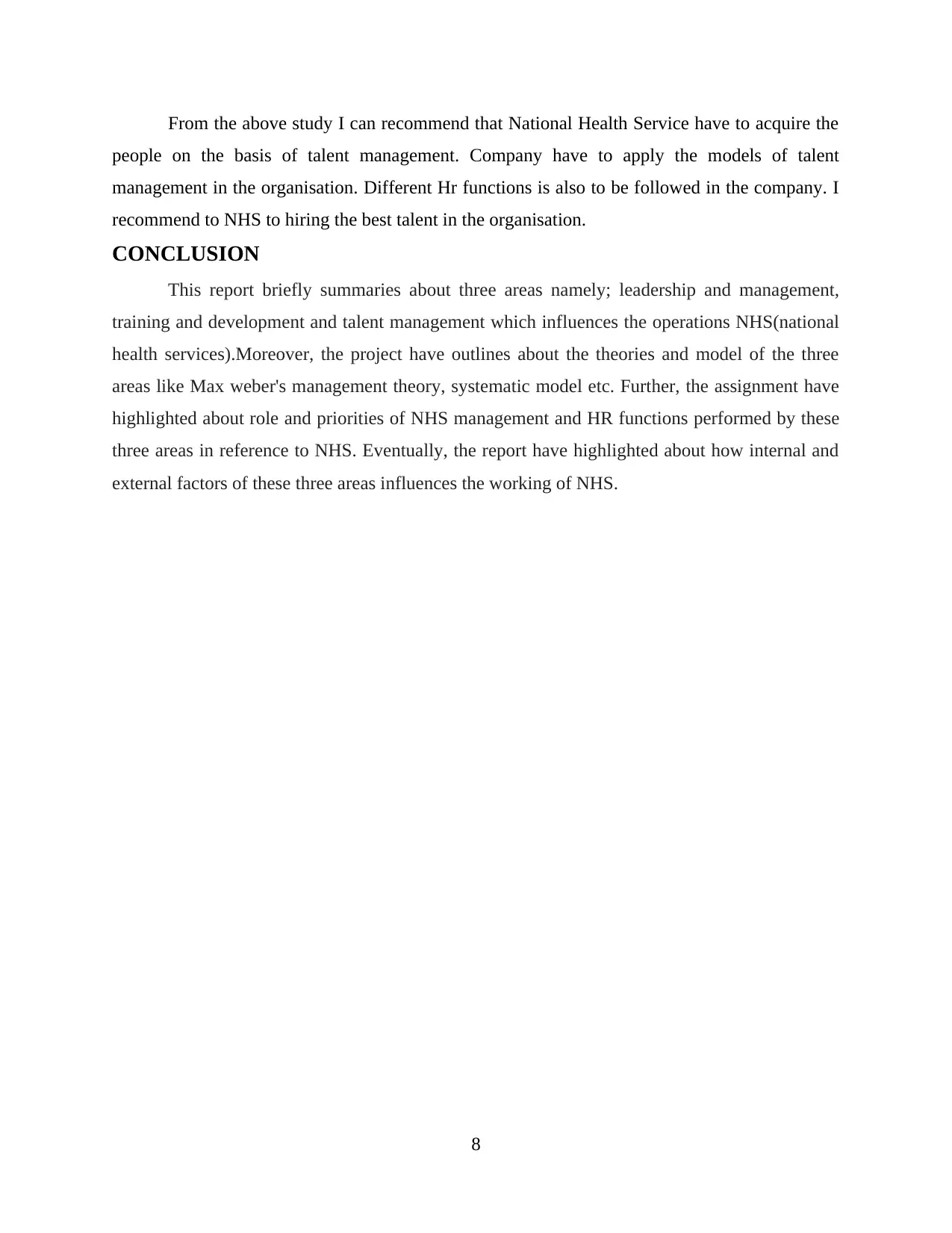
From the above study I can recommend that National Health Service have to acquire the
people on the basis of talent management. Company have to apply the models of talent
management in the organisation. Different Hr functions is also to be followed in the company. I
recommend to NHS to hiring the best talent in the organisation.
CONCLUSION
This report briefly summaries about three areas namely; leadership and management,
training and development and talent management which influences the operations NHS(national
health services).Moreover, the project have outlines about the theories and model of the three
areas like Max weber's management theory, systematic model etc. Further, the assignment have
highlighted about role and priorities of NHS management and HR functions performed by these
three areas in reference to NHS. Eventually, the report have highlighted about how internal and
external factors of these three areas influences the working of NHS.
8
people on the basis of talent management. Company have to apply the models of talent
management in the organisation. Different Hr functions is also to be followed in the company. I
recommend to NHS to hiring the best talent in the organisation.
CONCLUSION
This report briefly summaries about three areas namely; leadership and management,
training and development and talent management which influences the operations NHS(national
health services).Moreover, the project have outlines about the theories and model of the three
areas like Max weber's management theory, systematic model etc. Further, the assignment have
highlighted about role and priorities of NHS management and HR functions performed by these
three areas in reference to NHS. Eventually, the report have highlighted about how internal and
external factors of these three areas influences the working of NHS.
8
Paraphrase This Document
Need a fresh take? Get an instant paraphrase of this document with our AI Paraphraser
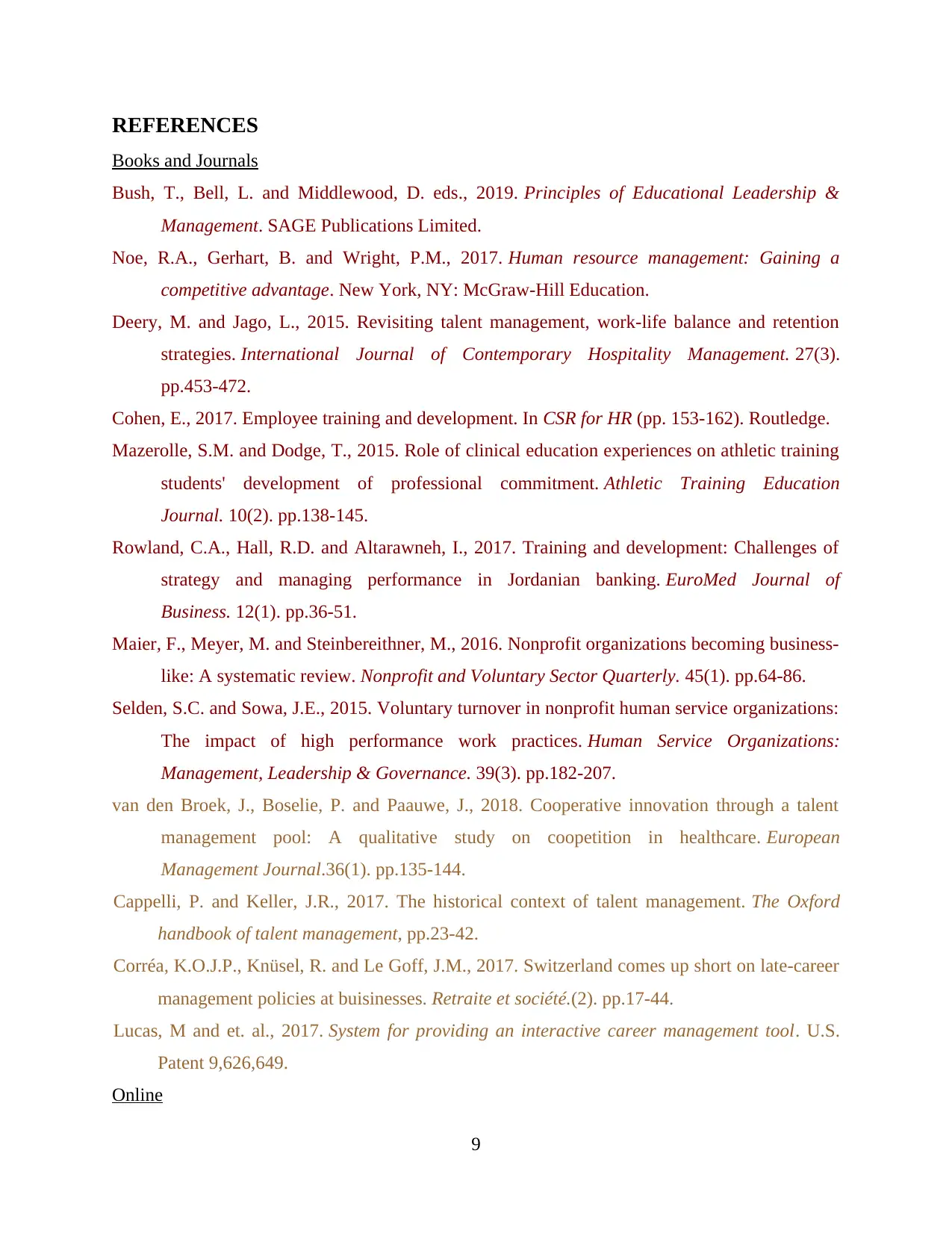
REFERENCES
Books and Journals
Bush, T., Bell, L. and Middlewood, D. eds., 2019. Principles of Educational Leadership &
Management. SAGE Publications Limited.
Noe, R.A., Gerhart, B. and Wright, P.M., 2017. Human resource management: Gaining a
competitive advantage. New York, NY: McGraw-Hill Education.
Deery, M. and Jago, L., 2015. Revisiting talent management, work-life balance and retention
strategies. International Journal of Contemporary Hospitality Management. 27(3).
pp.453-472.
Cohen, E., 2017. Employee training and development. In CSR for HR (pp. 153-162). Routledge.
Mazerolle, S.M. and Dodge, T., 2015. Role of clinical education experiences on athletic training
students' development of professional commitment. Athletic Training Education
Journal. 10(2). pp.138-145.
Rowland, C.A., Hall, R.D. and Altarawneh, I., 2017. Training and development: Challenges of
strategy and managing performance in Jordanian banking. EuroMed Journal of
Business. 12(1). pp.36-51.
Maier, F., Meyer, M. and Steinbereithner, M., 2016. Nonprofit organizations becoming business-
like: A systematic review. Nonprofit and Voluntary Sector Quarterly. 45(1). pp.64-86.
Selden, S.C. and Sowa, J.E., 2015. Voluntary turnover in nonprofit human service organizations:
The impact of high performance work practices. Human Service Organizations:
Management, Leadership & Governance. 39(3). pp.182-207.
van den Broek, J., Boselie, P. and Paauwe, J., 2018. Cooperative innovation through a talent
management pool: A qualitative study on coopetition in healthcare. European
Management Journal.36(1). pp.135-144.
Cappelli, P. and Keller, J.R., 2017. The historical context of talent management. The Oxford
handbook of talent management, pp.23-42.
Corréa, K.O.J.P., Knüsel, R. and Le Goff, J.M., 2017. Switzerland comes up short on late-career
management policies at buisinesses. Retraite et société.(2). pp.17-44.
Lucas, M and et. al., 2017. System for providing an interactive career management tool. U.S.
Patent 9,626,649.
Online
9
Books and Journals
Bush, T., Bell, L. and Middlewood, D. eds., 2019. Principles of Educational Leadership &
Management. SAGE Publications Limited.
Noe, R.A., Gerhart, B. and Wright, P.M., 2017. Human resource management: Gaining a
competitive advantage. New York, NY: McGraw-Hill Education.
Deery, M. and Jago, L., 2015. Revisiting talent management, work-life balance and retention
strategies. International Journal of Contemporary Hospitality Management. 27(3).
pp.453-472.
Cohen, E., 2017. Employee training and development. In CSR for HR (pp. 153-162). Routledge.
Mazerolle, S.M. and Dodge, T., 2015. Role of clinical education experiences on athletic training
students' development of professional commitment. Athletic Training Education
Journal. 10(2). pp.138-145.
Rowland, C.A., Hall, R.D. and Altarawneh, I., 2017. Training and development: Challenges of
strategy and managing performance in Jordanian banking. EuroMed Journal of
Business. 12(1). pp.36-51.
Maier, F., Meyer, M. and Steinbereithner, M., 2016. Nonprofit organizations becoming business-
like: A systematic review. Nonprofit and Voluntary Sector Quarterly. 45(1). pp.64-86.
Selden, S.C. and Sowa, J.E., 2015. Voluntary turnover in nonprofit human service organizations:
The impact of high performance work practices. Human Service Organizations:
Management, Leadership & Governance. 39(3). pp.182-207.
van den Broek, J., Boselie, P. and Paauwe, J., 2018. Cooperative innovation through a talent
management pool: A qualitative study on coopetition in healthcare. European
Management Journal.36(1). pp.135-144.
Cappelli, P. and Keller, J.R., 2017. The historical context of talent management. The Oxford
handbook of talent management, pp.23-42.
Corréa, K.O.J.P., Knüsel, R. and Le Goff, J.M., 2017. Switzerland comes up short on late-career
management policies at buisinesses. Retraite et société.(2). pp.17-44.
Lucas, M and et. al., 2017. System for providing an interactive career management tool. U.S.
Patent 9,626,649.
Online
9
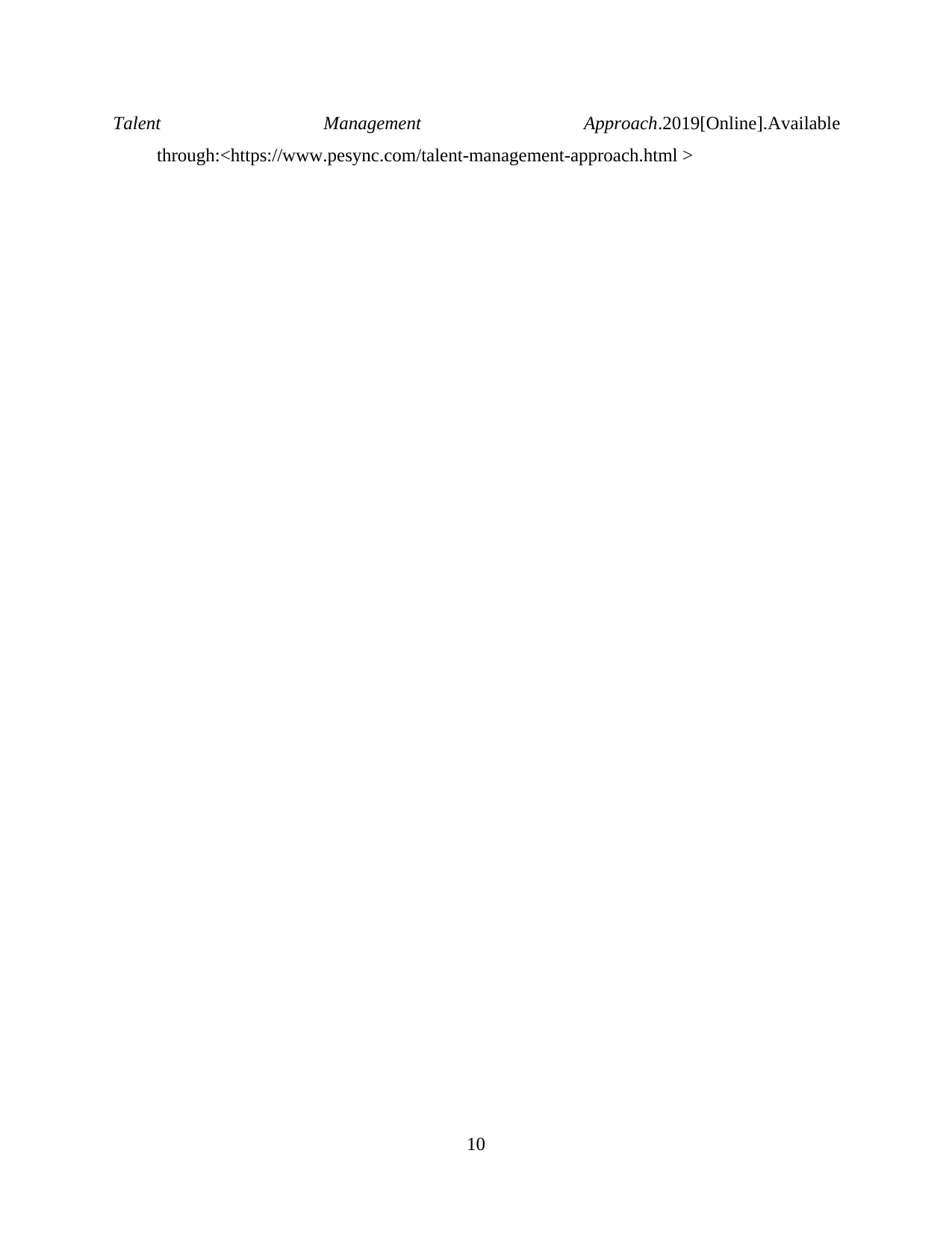
Talent Management Approach.2019[Online].Available
through:<https://www.pesync.com/talent-management-approach.html >
10
through:<https://www.pesync.com/talent-management-approach.html >
10
⊘ This is a preview!⊘
Do you want full access?
Subscribe today to unlock all pages.

Trusted by 1+ million students worldwide
1 out of 12
Related Documents
Your All-in-One AI-Powered Toolkit for Academic Success.
+13062052269
info@desklib.com
Available 24*7 on WhatsApp / Email
![[object Object]](/_next/static/media/star-bottom.7253800d.svg)
Unlock your academic potential
Copyright © 2020–2025 A2Z Services. All Rights Reserved. Developed and managed by ZUCOL.





